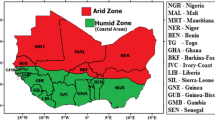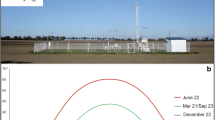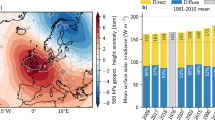Abstract
In the present experimental study, the dynamic properties of diffuse solar radiation have been assessed for both overcast and discrete clouds. It is shown that the Baseline Surface Radiation Network methodology can be accepted completely for studying diffuse radiation.
Similar content being viewed by others
Avoid common mistakes on your manuscript.
1 Introduction
The dynamic behaviour of global solar radiation has been studied in several papers (Tomson and Tamm 2006; Tomson and Hansen 2010; Tomson 2010). That is understandable to power specialists as it has a direct influence on electricity production. The president of the International Solar Energy Society (ISES), Dr D. Renne, underlined in his concluding speech at the EuroSun 2012 Conference that variability of renewable energy sources creates more significant problems for power systems than variability of the load. Dynamic behaviour of the diffuse fraction (diffuse radiation) is free from those problems, but should be studied too, considering the fact that it is the prevailing solar radiation in northern Europe, which is affected by frequent Atlantic cyclones. For instance in Estonia (58–59.5°N), half of the yearly solar energy received is represented by the diffuse fraction (Russak and Kallis 2003). In studying the behaviour of diffuse radiation, the first step is to prove that the widely used Baseline Surface Radiation Network (BSRN) method (McArthur 2005) gives trustworthy results. Secondly, we have to highlight that diffuse radiation exists under overcast clouds and in shadows of alternating discrete clouds (“broken clouds”; Klačka et al. 2012), which have different properties. Fog (smog) is an exceptional event in the Estonian summer season and is not the focus of the present study.
2 Datasets used
In this study, data measured with 1-s and 1-min sampling intervals are used. The data with the 1-s sampling interval were measured by the author in the 2012 summer season on a field polygon (59.36°N, 24.65°E, 60 m asl) which is a recultivated landfill hill of Tallinn City. This hill lies ~30 m above the surrounding landscape, providing a clear horizon for 360°, and is covered by grass (estimated albedo 20 %). The monitoring pyranometer used in this study is a photoelectrical model from SolData Instruments (DK), which has a transient time of a millisecond or less (personal consultation, SolData Instruments 2009, Silkeborg, Denmark). The data were stored in a Midi Logger GL200 data logger (Graphtec Corporation).
The data with the 1-min sampling interval were measured in the Tartu Observatory (TO, 58.25°N, 26.5°E) during 2000–2002 as beam and diffuse irradiance, and the global irradiance was calculated of these data. A detailed description of the field polygon of TO is shown in the study by Russak and Kallis (2003). We use the data for the summer season (April to September), when 82 % of the yearly energy yield is produced, presenting a practical interest in this region.
3 One-second dataset with alternating clouds
In these measurements, we record the global irradiance G 0(t) and its diffuse fraction G d0(t) in parallel on the horizontal plane (Table 1 and Fig. 1). All four measurements result in similar diagrams, and there is therefore no point in continuing with such measurements. In the second column of Table 1, the types of clouds are shown, but this assessment is quite subjective and unstable; we can see in Fig. 2 that after ~1,500 s (relative time), the diagram is affected by upper Cirrus clouds. The fourth and fifth columns of Table 1 show the average values of the diffuse irradiance in the clouds' shadows and in the sunny intervals between them.
Figure 1 shows the experiment. The first sensor is free; the second one has a 20° sector of the shading ring. An example of the simultaneously recorded irradiances is shown in the Fig. 2.
We can see that global radiation and its diffuse fraction are equal or very close in the shadows and influenced by the value of the global radiation, but not synchronously. In time instant “900”, the increase in diffuse radiation is delayed compared to the global one; in the time instant “1,200”, the fall in the global radiation is delayed compared to the diffuse one. Before the time instant ~1,500, the diagram is assessed for the classical single-layer Cumulus humilis (Fig. 3), but later, upper Cirrus clouds did appear.
In both situations (shadow and “sunny” windows), diffuse radiation is weakly correlated with the value of global radiation. In the “sunny” windows between clouds, the correlation is a little stronger (Fig. 4).
4 Dynamic behaviour of the diffuse radiation depending on the sampling interval
Figure 5 repeats the diffuse radiation from Fig. 1 but for several sampling conditions, as shown in the brackets.
G d0(1 s) is the natural recording with a 1-s sampling interval, while G d0(1 min) uses every 60th sampling to present the process. They almost coincide G d0(1 min) = G d0(1 s). The diagram G d0(BSRN) uses average values over 60 samplings and is slightly shifted with respect to the natural recording, but without distortions of the process. The average value of the natural recording is 153.5 Wm−2 (standard deviation 28.6 Wm−2). The average value of the recording obtained by the BSRN methodology is 153.2 Wm−2 (standard deviation 28.9 Wm−2). The error obtained by using the BSRN methodology is very low.
Figure 6 proves that autocorrelation functions (ACFs) calculated with the same sampling conditions coincide too. The correlation interval τ c found for all three versions is around 2 min, which shows that diffuse radiation changes slowly and BSRN methodology is acceptable for analysing it.
5 Stability of the diffuse radiation
The dynamic behaviour of the diffuse radiation has been studied on the basis of the 1-min dataset recorded by the BSRN methodology (Table 2). From three summer seasons, 10 days with overcast conditions and 10 days with (rapidly) alternating discrete clouds have been chosen for the analysis, and in this way, this regime is valid for the whole recording duration (8 or 12 h).
In this table, global radiation G 0 is assessed on the horizontal plane and G d0 is its diffuse fraction. Both of them are averages of the values obtained during recording. On overcast days, G d0 ≈ G 0 and their ratio is close to 1. In the case of alternating clouds, G d0 < G 0 and their ratio varies significantly depending on the degree of cloudiness and height of the sun. The date of 12 June 2000, which is marked with an asterisk in Table 2, is exceptional due a long shadow that occurred around noon: to calculate the ACF the time interval 10:00–14:00 (solar time) was used as then the height of sun does not change much (this means that the recording has the best fit with a stationary process). Due to the long shadow, the ACF of the global radiation (Fig. 7), on this day (000612), is close to the ACFs of overcast days.
The remaining (nine) ACFs lie between the lines “min” and “max”, and the bold dashed line is their average value. Their correlation interval has a value in the range 2 < τ c < 5 min. The same style of presentation has been used for the ACFs of the diffuse radiation (Fig. 8) in these conditions too.
Their correlation interval has a larger value in the range 3 < τ c < 10 min. Diffuse radiation in the overcast conditions is most stable because its correlation interval is obtained in the range 10 < τ c < 30 min (Fig. 9).
6 Summary
The dynamic behaviour of diffuse radiation depends on the character of clouds. In conditions of (fast) alternating clouds, its value is higher than in overcast conditions, and it is weakly correlated with the value of global radiation. In these conditions, global radiation and its diffuse fraction do not change synchronously. Recording diffuse radiation, the sampling interval may be in the order of 1 min studing its dynamic behaviour and their phase shift is random. Diffuse fraction is more stable than the global radiation at the alternating cloudiness. Diffuse radiation under an overcast sky is most stable.
References
Klačka J, Kocifaj M, Tomkova Z (2012) Cellular statistical models of broken cloud fields. In: EuroSun 2012—ISES-Europe Solar Conference, Rijeka, 18–20 Sept 2012
McArthur LJB (2005) Baseline Surface Radiation Network (BSRN) operations manual. WMO/TD-No 1274. World Meteorological Organization, Geneva
Russak V, Kallis A (2003) Handbook of Estonian solar radiation climate. EMHI, Tallinn
SolData Instruments (2009) Personal communication, SolData Instruments, Silkeborg, Denmark. http://www.soldata.dk
Tomson T (2010) Fast dynamic processes of solar radiation. Sol Energy 84(2):318–323
Tomson T, Hansen M (2010) Fast changes of the solar irradiance. Est J Eng 16(2):176–183
Tomson T, Tamm G (2006) Short-term variability of solar radiation. Sol Energy 80:600–606
Author information
Authors and Affiliations
Corresponding author
Rights and permissions
About this article
Cite this article
Tomson, T. Dynamic behaviour of diffuse solar radiation. Theor Appl Climatol 117, 399–402 (2014). https://doi.org/10.1007/s00704-013-1010-1
Received:
Accepted:
Published:
Issue Date:
DOI: https://doi.org/10.1007/s00704-013-1010-1













